Originally posted on Boys’ Life
Campout cooking doesn’t have to mean Dutch ovens or dehydrated food. We scoured cookbooks, the Internet and our memories for these six strange recipes and oddball cooking methods. Then we challenged a Scout troop to try them out.
The result? Lots of laughs — and some surprisingly good chow.
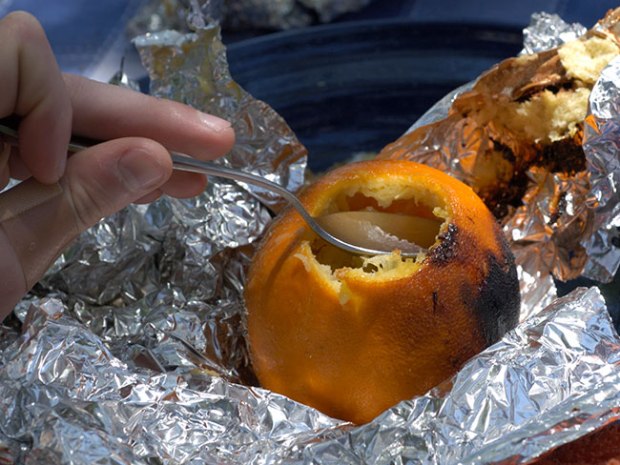
Orange Peel Cakes
THE CHALLENGE: Bake cakes in the coals.
INGREDIENTS:
- 1 8 oz. box Jiffy yellow cake mix
- 1 egg
- 1/2 cup water
- 6 large, thick-skinned oranges
Cooking a cake on coals is a snap when you use a hollowed-out orange peel instead of a pan.
The Scouts combined the cake mix, egg and water and stirred up some batter. Then they cut a small “lid” in the top of each of six big navel oranges and scooped out the insides, just like carving a pumpkin. They were very careful not to damage the shell.
The Scouts ate the orange pulp, then poured the cake batter into the gutted oranges, each about two-thirds full.
They popped the “lids” back on the oranges, wrapped them in heavy foil, and set them on the coals for about 20 minutes, turning them often.
THE RESULT: The orange-peel cakes were a hit. Spongy and moist, with a hint of, well, orange, they could be eaten with a spoon or peeled for a hot orange cake.

Pinto Bean Fudge
THE CHALLENGE: Don’t think about it — just keep stirring.
INGREDIENTS:
- 2/3 cup sweetened condensed milk
- 1 1/2 cup mini marshmallows
- 1 can pinto beans, drained
- 1 teaspoon vanilla
- 1 2/3 cup sugar
- 1/2 cup chopped nuts
- 1 1/2 cup chocolate chips
- Butter for greasing pan
 Pinto Bean Fudge is for real, thanks to a long-ago camper who discovered that a can of pinto beans can be substituted for a pound of butter when making fudge.
Pinto Bean Fudge is for real, thanks to a long-ago camper who discovered that a can of pinto beans can be substituted for a pound of butter when making fudge.
To make it, the Scouts combined sugar and milk in a large pan and boiled it for 5 minutes, stirring constantly. They then added the remaining ingredients (including the beans!) and stirred until the marshmallows melted. Finally, they poured the finished fudge into a shallow, buttered pan and tucked it in the cooler to chill.
THE RESULT: Delicious, with no hint of an aftertaste from the pinto beans.

Dingle Fan Chicken
THE CHALLENGE: Can something called a “dingle fan” cook chicken at all?
EQUIPMENT:
- Long pole (a broom handle works well)
- 6-inch length of chain
- Heavy string
- Wire
- Wire cutters
- Paper plate
- Skewer or short stick
- Large and small rocks
- Instant meat thermometer
- 2 “S” hooks or additional wire
INGREDIENTS:
- Whole chicken
- Seasonings
- Butter for basting
Dingle fan roasting is for campers who have better things to do than fuss over their food. Rather than endlessly basting and turning a piece of meat over a fire, campers can let this fan-powered rotisserie do the work.
The Scouts wedged a long wooden pole between two rocks so that it angled very near — but not directly over — the flames. Next, they attached a short length of chain to the end of the pole using the wire and “S” hooks.
The next step was to make the dingle fan by sticking a paper plate on the end of a metal skewer. The fan would be attached to the chain, from which a raw chicken would hang. (Be sure to leave enough space between the fan and the flames, since that plate could catch fire if it’s left too close.) A small rock or other was attached to the free end of the skewer to counter-balance it and make it level.
If everything was set up correctly, the heat from the fire should hit the fan, causing the chicken to slowly rotate throughout the cooking process.
All we needed now was a chicken, innards removed, seasoned and buttered and bound in string.
Once dangling from the chain, the chicken wouldn’t need tending other than basting it occasionally with butter. After about two hours, it should be fully cooked, but the Scouts planned to check it with the meat thermometer to be safe.
THE RESULT: Even after falling into the dirt a couple of times, the Dingle Fan Chicken was a thing of beauty. The fan had worked. The chicken was golden and crispy on the outside and perfectly cooked on the inside.
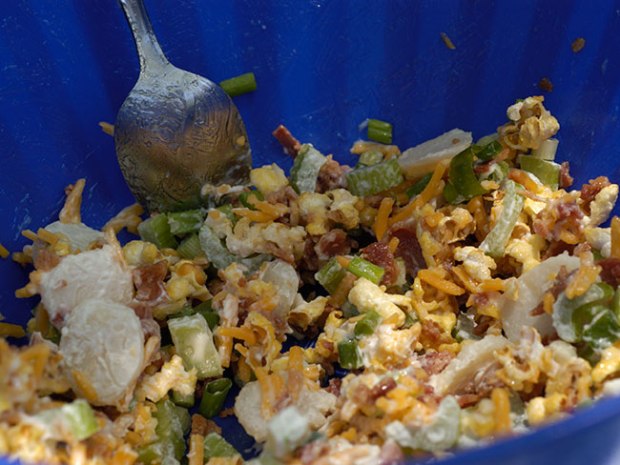
Jiffy Pop Salad
THE CHALLENGE: Turn pop corn into a meal.
INGREDIENTS:
- 1 package Jiffy Pop popcorn
- 3/4 cup mayonnaise
- 1 cup diced celery
- 1 1/4 cup grated cheddar cheese
- 1 8-ounce can water chestnuts, drained
- 3/4 cup crumbled cooked bacon
- 1/4 cup shredded carrot
- 1/4 cup minced chives
Jiffy Pop Salad combines popcorn, bacon and celery mingled with mayonnaise for an unusual flavor combination.
The Scouts popped popcorn over the camp fire, blended it with the remaining ingredients and served immediately.
THE RESULT: Not surprisingly, this recipe isn’t a huge hit with all the Scouts, although it got good reviews from some of the tasters.
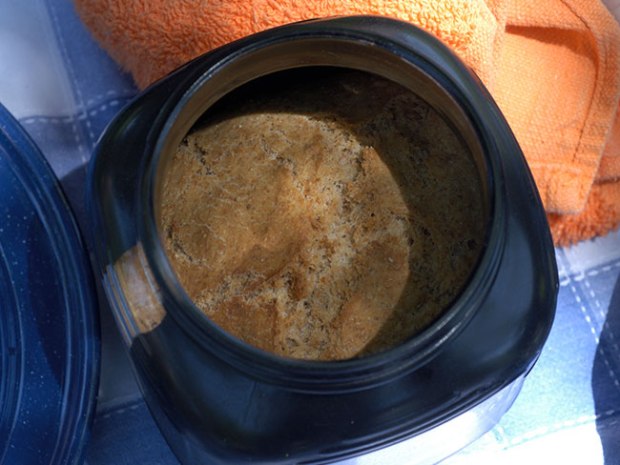
Solar Oven Bread
THE CHALLENGE: Bake a loaf of bread … without fire or electricity.
EQUIPMENT:
- Jar, painted black on the outside
- 2-foot by 4-foot sheet of cardboard
- Aluminum foil
- Clear plastic bag
INGREDIENTS:
- Premade, refrigerated bread dough (or make it homemade)
Cooking with the power of the sun is ideal for campers who want to try something fun and different.
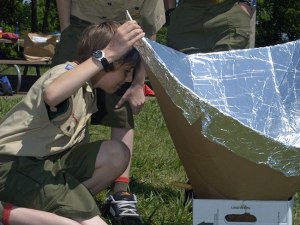 Our solar oven called for bending a 2-foot-by- 4-foot sheet of cardboard into the shape of a funnel and covering the inside with aluminum foil. When the funnel is angled toward the sun, heat builds up in the base of the funnel.
Our solar oven called for bending a 2-foot-by- 4-foot sheet of cardboard into the shape of a funnel and covering the inside with aluminum foil. When the funnel is angled toward the sun, heat builds up in the base of the funnel.
The Scouts made bread dough and kneaded it for about five minutes before putting it into a two-quart jar, spray-painted black to make it absorb more heat. They could have also used premade, refrigerated dough.
Before putting the jar into the funnel, the Scouts slipped it into a clear plastic bag, then blew air into the bag and closed it with a twist tie. This extra step created a “greenhouse effect” around the jar, allowing for additional heat build-up.
If all went well, the dough would rise inside the jar and, perhaps, bake.
THE RESULT: The Scouts kept their eyes on the solar oven all afternoon and had given it an occasional nudge to keep it in the path of the sun’s rays. Its temperature had peaked at 310 degrees. Not only had the dough risen, it had baked to perfection, filling the jar.
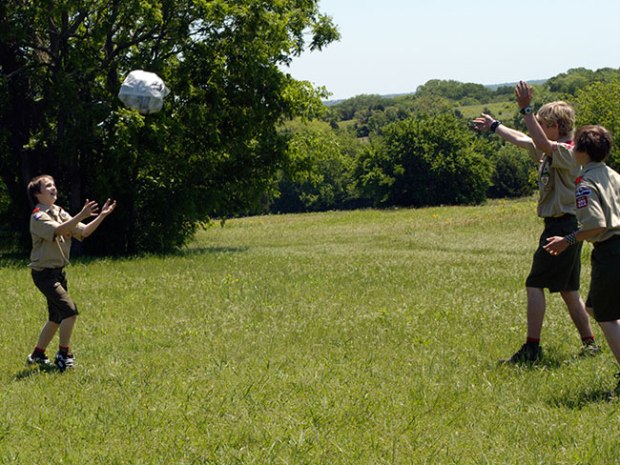
Ice Cream Football
THE CHALLENGE: Make ice cream without a freezer
EQUIPMENT:
- 2 (1-quart) zip-top bags
- 2 (1-gallon) zip-top bags
- 1 (8-pound) bag of ice, crushed or in cubes
- 1/2 cup rock salt
- Newspaper
- Heavy-duty tape
INGREDIENTS:
- 1 cup whole milk
- 1 cup whipping cream
- 1/3 cup sugar
- 1 teaspoon vanilla extract
You need milk, cream and sugar to make ice cream, plus rock salt and lots of ice. As long as the ingredients keep moving and stay cold enough, the mixture will turn into ice cream.
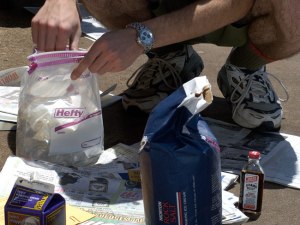 The Scouts measured the ingredients into a quart-size zip-top bag, and squeezed out all the air and sealed the bag. They placed this bag inside the other quart bag and sealed it. Then they put this double-bagged ice cream mix inside a gallon zip-top bag.
The Scouts measured the ingredients into a quart-size zip-top bag, and squeezed out all the air and sealed the bag. They placed this bag inside the other quart bag and sealed it. Then they put this double-bagged ice cream mix inside a gallon zip-top bag.
They then filled the gallon-size bag with ice, sprinkled the ice with rock salt and sealed the bag. They placed this bag inside the other gallon bag and sealed it again.
Now for the football part.
The Scouts wrapped the bags in layers of newspaper and secured the bundle with duct tape. The resulting “football” was ready for about 20 minutes of passing — to keep the mixture moving — before being spiked into the ice chest.
THE RESULT: The ice cream was cold and delicious.

